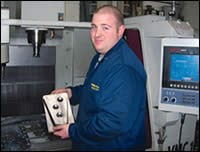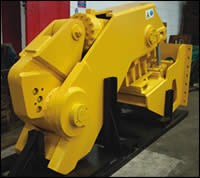Machine Combo Strengthens Company Invention
Brian Purser and his son, David, run a successful development and manufacturing operation, Mobile Frag Sales (Staffordshire, United Kingdom), producing and assembling the company’s cutting and shredding equipment. The two versions of the 562.1-ton and 264.5-ton Rail Cropper, which are used to chop railway track into manageable lengths, have been successful in the European market. Using the Colchester Lathe, the company was able to bring its operations in-house.
Brian Purser and his son, David, run a successful development and manufacturing operation, Mobile Frag Sales (Staffordshire, United Kingdom), producing and assembling the company’s cutting and shredding equipment. The two versions of the 562.1-ton and 264.5-ton Rail Cropper, which are used to chop railway track into manageable lengths, have been successful in the European market. As a result of the increasing production capability at the facility, a new assembly operation is being established in North America to penetrate the U.S. market.
A one-man excavator, fitted with the hydraulic shear unit, can complete a trackslide task in less than 20 minutes. “This would take a team of men with blow torches 30 hours to achieve,” says David, the company’s director. “One of our main problems was to control the Rail Cropper’s build and quality,” David explains. “We used to subcontract machining under license until the summer of 2005, but because of a few problems, we decided to approach several machine tool suppliers about installing our own equipment to bring this manufacturing in-house. We quickly found that Colchester Lathe (Clausing Industrial Inc.) was able to supply two CNC lathes and a machining center to cover all our requirements.”
Mobile Frag Sales wanted a single source that could ensure good after-sales support for these machines. The equipment had to be able to provide a combination of power and capacity, have very simple-to-use programming software and maintain the ability to machine to high accuracy. “We were not particularly interested in cycle times,” David says. “Quality and functionality was the order of the day, so we ordered two Colchester MultiTurn combination CNC lathes, with bed lengths of 2,000 mm and 4,000 mm, and a Richmond VMC 1000 vertical machining center.”
The company’s production team was trained by Colchester Lathe. As well as moving from machine to machine to produce eight- and 16-part batches, the team is also required to produce prototype and development parts for Brian’s continual stream of ideas, along with fixturing and tooling.
Typical components produced at the shop include ram tubes, hydraulic cylinder piston rods, ram eyes, cylinder glands and hydraulic unions. “The Colchester MultiTurn lathes have proven to benefit the company because of the high levels of inherent flexibility we can take advantage of,” David says. “We do not grind—we turn to size, and the machines are fully capable of holding 0.07-mm tolerances on a 272-mm-diameter cylinder bore that is 1,000-mm deep, as well as on 600-mm-long piston rods with a 0.02-mm tolerance on a 79-mm outside diameter.”
Both MultiTurns are flat-bed machines that have a common Fanuc 0i-TC control with the Manual Guide 0i conversational programming assistance and electronic handwheels. The on-screen programming involves direct input of drawing dimensions that is especially useful for the variety of component types produced at Mobile Frag Sales. The control also allows the onboard library of macros to be called up and customized to what is specifically required, further simplifying programming and presenting a clear representation of toolpath graphics on the screen.
The shop has taken advantage of using the Richmond VMC by implementing the machine’s maximum capabilities. On a 180-mm-thick ram eye, for instance, the part is U-drilled from solid metal to 45-mm diameter and interpolated to 125-mm diameter, taking 5-mm depths of cut. It is then finish bored to a 0.075-mm tolerance. The machine has a table that is 1,120 mm × 510 mm, which offers ample space for the company’s machining requirements, plus an 11-kW BT40 heavy-duty spindle and 20-tool carousel.
The Rail Cropper is a self-contained unit that is carried and powered by the hydraulic system of the excavator, making the device mobile and very flexible. In use, it simply chops the rail line into 6-meter lengths ready to be lifted by a crane onto suitable transport. David explains how the “inventiveness” of the unit, which took 18 months to perfect, involves avoiding shock during the cut. The design enables the unit to be easily positioned so the moving jaw pressurizes the rail against a fixed anvil. A stress fracture is created across the “ball” top of the rail, and the steel cracks into two parts.
Indeed, the jaws are the critical area of the cropping device, and they have a life expectancy of some 440.9 tons of rail. They are produced from a special cast ingot specified by Brian that is rolled into a special section ready for machining on the Richmond machine. Such has been the success when machining these toughened jaws that David has ordered another Richmond with multiple pallet loading capability. It will be turnkey engineered by the Colchester Lathe application team.
An increase in production is planned at Mobile Frag Sales as new business is being won through agents appointed in Holland, France, Germany, Denmark, Sweden, Finland, Norway and the United States as well as from two sales offices in Russia. Other agencies are also being appointed in other parts of the world, helping to increase the projected build target to 6,000 units a year throughout the next 15 years.
However, with Brian’s roving eye for new ideas, it is no surprise that several other types of equipment are already being developed by the company.
Related Content
Video: The Value of a Desktop CNC Swiss-Type
This Swiss-type requires only 120 volts of power, basic compressed air supply, weighs in at 150 pounds and needs a table that’s only maybe two by four feet. But it’s by no means a toy.
Read MoreKeeping Watch on Small Parts
From watch parts to exotic medical applications, this shop takes on the world of micromachining.
Read MoreCAM-Driven Lathe Questions
There can be hidden issues using legacy cam-driven lathes that can be overcome using new CNC technology. Here are three to keep in mind.
Read MoreLaser Technology "Turns" into a Turning Tool
This new technology uses a laser to act as a cutting tool to "turn" parts from solid barstock. This high-speed precision turning machine is especially useful for micromachining, enabling high accuracy for small, complex parts that are often delicate and difficult to machine when implementing conventional turning processes.
Read MoreRead Next
How To (Better) Make a Micrometer
How does an inspection equipment manufacturer organize its factory floor? Join us as we explore the continuous improvement strategies and culture shifts The L.S. Starrett Co. is implementing across the over 500,000 square feet of its Athol, Massachusetts, headquarters.
Read MoreFinding the Right Tools for a Turning Shop
Xcelicut is a startup shop that has grown thanks to the right machines, cutting tools, grants and other resources.
Read More























